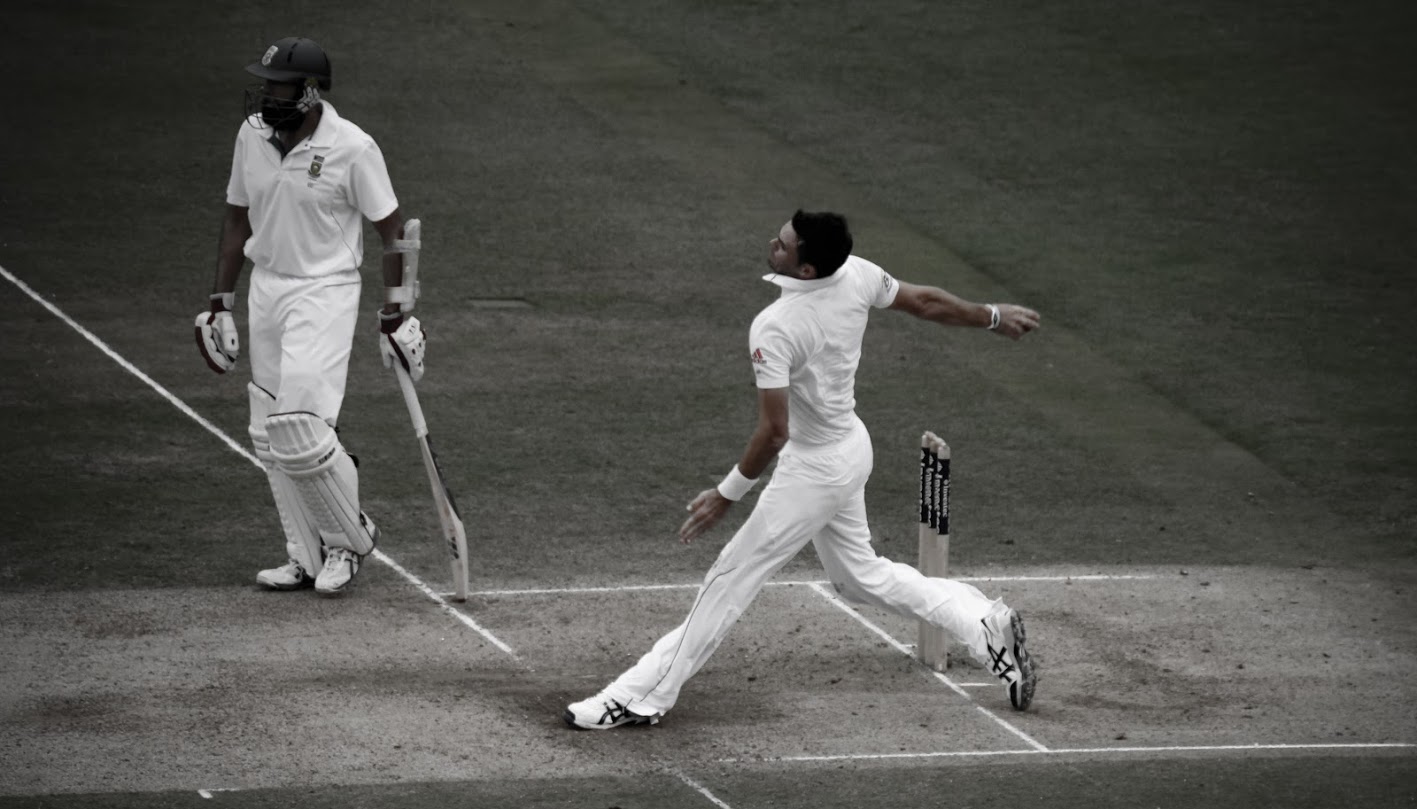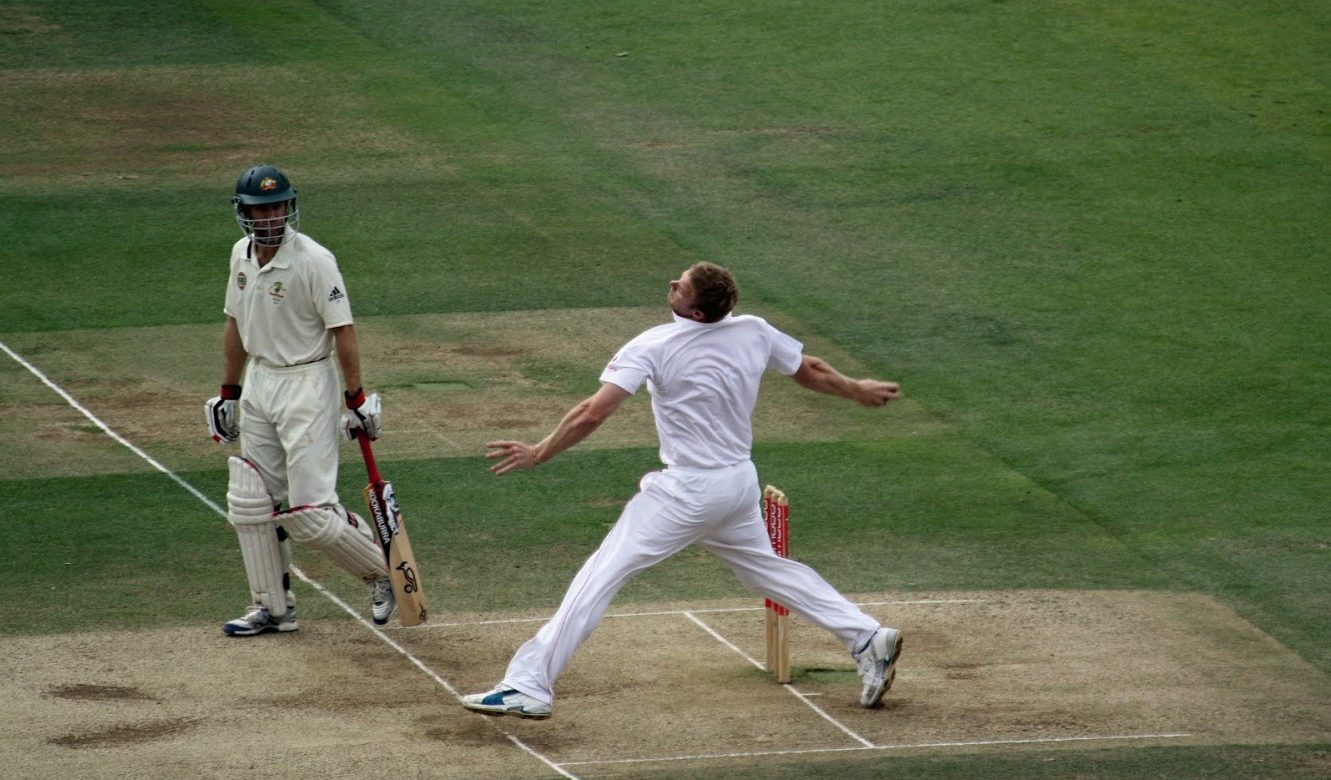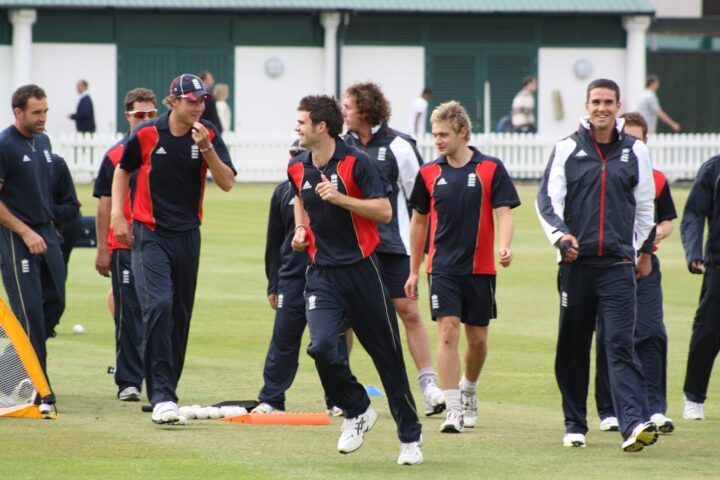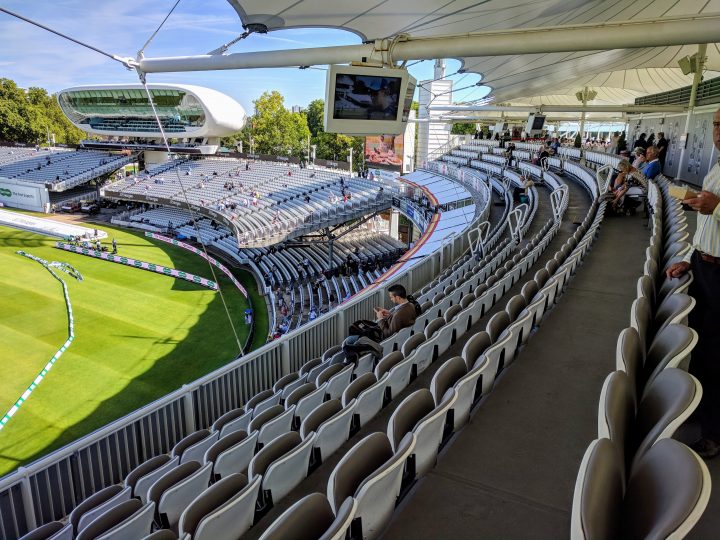Today, James Walker looks back at the tour that created England’s most prolific pairing…
England cricket fans will have enjoyed the first Test against NZ at Bay Oval in Mount Maunganui, Bay of Plenty and a thrilling finish at the Basin Reserve, Wellington. Am I alone in not regretting the loss too much? Seemingly, there is so much life in the England squad these days that we can stomach a loss because the boys had their swords in their hands.
Besides Harry Brook’s fabulous batting, the game at Bay Oval saw an incredible milestone when – having previously surpassed the 895 of Murali and Chaminda Vaas, and the 762 of Courtney Walsh and Curtly Ambrose, James Anderson and Stuart Broad overtook the tally of 1,001 wickets taken by Shane Warne and Glenn McGrath. The serendipity would have been more intense, however, had they accomplished the feat in Wellington. After all, this is where their partnership had begun 15 years beforehand. There was also immense sadness, of course, that Shane Warne wasn’t around to have a celebratory beer with the new record-holders.
Bay Oval is a fairly new ground that only hosted its first Test in 2019. This was also against England, and the hosts enjoyed a thumping innings victory of their own after accumulating 615-9d against an attack of Broad, Archer, Sam Curran, Leach, Stokes and Root. Four years later, Archer and Curran were replaced by James Anderson and Ollie Robinson.
Unfortunately for NZ though, their bowling attack was a good bit weaker than it had been in the 2010s. The left-arm assassin Trent Boult has retired from Test cricket, the Joel Garner-esque Kyle Jamieson is injured, and the dangerous quick Matt Henry was away becoming a father. That left two debutants, Scot Kuggeleijn and Blair Tickner, to partner the veteran seamers Neil Wagner, almost 37yrs, and skipper Tim Southee, 34yrs. As we know, supplemented by offie Michael Bracewell, NZ’s attack was unable to halt the juggernaut momentum of new England.
This was England’s first victory on NZ soil since spring 2008, after two losses and five draws in the interim. In the second innings 36yr old Stuart Broad removed NZ’s top order with four wickets in 27 balls – all comprehensively bowled – finishing with match figures of 32-7-121-5, whilst Jimmy Anderson’s were an incredible 27.2-8-54-7. Anderson and Broad became Test cricket’s most prolific pair of bowlers. They took a combined 12-175 in the match, and are now in the process of setting a mark that will surely never be matched.
How it all came to pass is an interesting tale. Already a seasoned ODI England-rep, Broad had obviously impressed on tour – at 21yrs, he had boundless energy and had done very well in the T20s and ODIs. Not so James Anderson. His form had been dire, and he was lucky to start the second Test; therefore their partnership might have begun somewhat later; or perhaps never, had the selectors been as capriciously dismissive of him as they had been with a large number of other bowlers.
March 2008, was fifteen years ago. The IPL was just about to start, Gordon Brown, a man known for saving the world whilst flinging telephones across rooms, was still British PM, Heathrow’s Terminal 5 opened without a properly functioning baggage retrieval system, Ireland still had another year to wait before their first Six Nations Grand Slam since 1948, Vietnam had just banned the ownership of pet hamsters, and Michael Vaughan was still captain of the England cricket team. He was taking his men to New Zealand for a 3-test series, to be preceded by two T20s and five ODIs under the captaincy of Paul Collingwood.
England were looking to rebuild. The 2005 Ashes heroes had fallen away: two Joneses, Giles and Trescothick, Flintoff’s body was creaking and Strauss’s form had crumbled. The magic was fading for Vaughan too, and Hoggard and Harmison had lost potency. Only the prodigious talents of Pietersen and Bell worried opponents, whilst Collingwood’s all-round excellence was vital cement.
A comprehensive defeat in Sri Lanka a few months earlier demonstrated that England were a WAHO side – ‘wins at home only’. England were without an away series win away before the magical Ashes series, and this NZ trip would be their only series win on foreign soil until 2010, when Alistair Cook’s captaincy apprenticeship began in Bangladesh, which was followed by that ultra-rare sporting triumph, an away Ashes victory. ‘Twas ever thus: in the 1980s ENG won 4 of 13 away series, in the 1990s 2 of 12 and 2000s, an only slightly better 6 of 17.
This would be England’s seventeenth trip to New Zealand, and, after 11yrs, selection for it was David Graveney’s final task, before he handed over to Geoff Miller as chief picker. Along with James Whitaker, and the captain and coach, Peter Moores, he had picked a party of mostly mature cricketers: the skipper, and those already mentioned, alongside younger players who had more recently established themselves: Anderson, Cook, Panesar and the older Sidebottom. Of the remainder, Tim Ambrose, Graeme Swann and Phil Mustard were uncapped, whilst Broad had one, Owais Shah two and Chris Tremlett three. Ravi Bopara had been dropped after making 42 runs in five innings in Sri Lanka – as was Matt Prior, despite averaging 42.
The 2008 NZ tour started with a flourish. T20 had been going for three years, and, despite creaming Australia in their first ever game, at Southampton, England had been poor at it – only beating Zimbabwe at the inaugural T20 WC in South Africa the previous autumn – when Yuvraj Singh smote Broad for six sixes. It was somewhat refreshing then to see England twice beat NZ soundly. They were not games that James Anderson relished though. He posted combined figures of 8-0-67-2, which was roughly how his T20 record looked when he quit the format with 18 wickets in 19 games. It was not for him.
Never mind, the team had won, and, with Pietersen, Collingwood and Sidebottom showing good form, the camp was optimistic about the five ODIs. Things did not turn out so well though. In the first two games ENG batted poorly, conceding six run-outs as they were bowled out for 130 and 158. The bowling was insipid too, they took only four wickets. James Anderson’s cumulative figures were 9-0-78-0, as NZ’s top order of Brendan McCullum, Jesse Ryder, Jamie How and Ross Taylor unequivocally clicked.
In the third game, Bell, Pietersen and Collingwood put together a successful run chase after Anderson had bowled better. This was the only match in which England managed to take a clutch of wickets in the first third of the innings. In the fourth game at Napier, England set a challenging 340, but Ryder and McCullum took 44 from Anderson’s first four overs – he ended up with 10-0-86-1 – and Jamie How scored an 86-ball ton. Luke Wright bowled a very good final over to salvage a tie. This meant that England could square the series if they won in Christchurch.
England kept faith in Anderson, hoping that he might find form. He did not, or rather he was not allowed to by McCullum. Chasing England’s 242 on a grey evening, things started well enough, NZ 4-0 after two. Then McCullum climbed into Anderson, taking 16 from his third over, hitting him out of the attack. He then hit Sidebottom for two sixes. Anderson only missed one over and was back, but McCullum hit 20 off him in a 27-ball fifty. Collingwood then elected to bowl himself and Mascarenhas to take the pace off the ball; it worked, McCullum fell for a 43-ball 77, bowled, hoicking at the England skipper. It mattered not though, for when the rain came, NZ were well ahead on D/L terms. Collingwood’s first six overs cost 13 runs, Anderson’s 56 – our hero was completely out of sorts.
The ODI series concluded on 23rd February. The Test series began at Hamilton on 5th March. In between times, two warm-up matches had been scheduled in Dunedin to help the England players readjust, and to give experience to some Kiwi up-and-comers. Sidebottom had a hamstring niggle and was rested, but Hoggard and Harmison bowled aggressively to reduce the home team to 26-5. Anderson recovered a bit of form, taking three wickets and Stuart Broad scampered in for a dozen overs, too. In the second warm-up, Anderson and Broad were the reserves as England fielded Chris Tremlett, and gave the first choice pair a good workout of 30-odd overs each.
The two practice matches went pretty well for both the England batsmen and the bowlers. When the Test team was announced, the bowling attack was to be Hoggard, Harmison, Sidebottom and Panesar, with Collingwood’s useful nibblers for a change. Note, at this time Anderson was 25yrs old, and had 20 caps. In those games, he had taken 62 wickets at 39.2, with a strike-rate of 62.7. Mediocre at best.
What also might be recalled is that Anderson was not the only one searching for form. Skipper Michael Vaughan was showing signs of being frazzled, and Andrew Strauss’s career was faltering badly. It had begun in 2004 in stunning style with four hundreds and nearly a 1000 runs. He performed creditably in the 2005 Ashes, at the end of which he had a career average of 50. This fell away, and it seemed that every time his place was called into question, he would score a hundred, before another run of so-so scores. He was not selected for the trip to Sri Lanka, 22yr old Ravi Bopara came in, and England rejigged their order, but – fortunately for Strauss – he did not take the opportunity. By spring 2008, Strauss’s average was 40, and at the age of 31yrs he was clearly in NZ on a make-or-break ticket.
Hamilton’s Seddon Park is an attractive tree-ringed ground, inside which, as is the case at most grounds in NZ, the majority of spectators sprawl on grassy banks. NZ first played there in 1991 and usually prospered. It was England’s first visit, and it was anticipated that the batting would spark, and that Hoggard and Harmison would flourish too. Instead, the match would be a watershed for English seam bowling. NZ had their own significant moment too, for their fine captain and batsman Stephen Fleming was retiring at the series end, just before his 35th birthday. He would compile six very solid innings that would be enough to take his Test average back over 40, which was a fitting reward.
NZ won the toss and batted, and piled-up 470. This could have been more but for Sidebottom’s sterling 4-90 as Hoggard and Harmison went missing. In response, England posed a solid 348 – all batsman made starts but were unable to progress beyond Collingwood’s 66. In the second dig, NZ were seriously pegged back by Sidebottom’s magnificent 6-49, which included a hattrick. Hoggard bowled better, but was toothless. Harmison went missing again and for the most part bowled below 80mph, quicker than Collingwood, but not that much. Panesar had to hold the fort at one end, which he did to reasonable effect, claiming three wickets with good economy.
On the last morning, NZ batted for half-an-hour and declared on 177-9, leaving England 300 to win. By lunch they were 36-4, and they did not make it to tea – all out for 110. The scorecard showed that nine men failed to make double-figures. Bell was 54no, Cook made 13, and extras was the third highest contribution. This feeble performance came three months after being bowled out for 81 by Sri Lanka in Galle.
James Anderson was missing at Hamilton too. He was up in Auckland at Eden Park. England’s bowling coach Ottis Gibson had friends in Auckland cricket, and they had contacted him, asking to borrow Chris Tremlett for a state game against Wellington because they had two quicks with NZ and two more over in India at the IPL. Tremlett didn’t fancy it, but Anderson thought playing a game would be useful to him. He went up to the City of Sails and played with a young Martin Guptill and Colin de Grandhomme. His figures were 32-13-95-2, but more importantly he found rhythm.
Auckland’s enterprise did not go down well with NZ Cricket, CEO Justin Vaughan said, “We would have been happier had Auckland given a chance to a young NZ bowler, because we can foresee a scenario where Anderson bowls himself into form”. The Kiwi press were in uproar, and even today, now England coach Brendan McCullum still chunters about it.
On that losing trip to SL, Anderson had played in the first Test at Kandy, and Broad in the second at Colombo (his debut) but neither played at Galle. The England bowling attack had been limp and took just 35 of a possible 60 wickets, as Mahela Jayawardena, at the height of his powers, scored 474 runs in four innings.
After the debacle of Hamilton, there was a squad ‘honesty session’ and then Vaughan, Moores and Whitaker made three decisions: first, that radical selectorial surgery was required; second, that there was a good chance that Anderson’s Auckland sojourn had been beneficial, so he would play instead of Hoggard; and lastly, that Stuart Broad, and not Chris Tremlett would replace Harmison.
So, Anderson and Broad began their partnership, in support of Ryan Sidebottom in NZ at Wellington’s Basin Reserve on 13th March 2008 – though it was actually the 14th when their first wickets were reaped. Anderson opened the bowling with Sidebottom, and bowled with the relentless accuracy that these days we take for granted. He removed NZ’s top order for 73 runs. His first spell was 9-2-20-3, and NZ were 40-3. At tea NZ recovered to 100-3.
After the interval, Sidebottom and Anderson resumed and bowled beautifully. Another first hour saw NZ at 134-6, in which time Anderson’s spell was 6-2-14-2, and Sidebottom’s an almost identical 6-1-14-1. However, at 113-6, Daniel Vettori joined McCullum at the wicket. After drinks, they combined to dent the bowlers’ figures, taking 24 from two overs. On came Broad for his eighth over and ended the partnership with his first Test wicket – Brendan McCullum. NZ would last only another ten overs, as Collingwood bowled well to double his Test tally in taking the last three wickets. NZ were all out for 198.
In the first innings, Tim Ambrose had scored 102 in his second match, and Collingwood 65, taking England from an iffy 136-5 to 300-6. Second innings, Cook top-scored with 60 and Collingwood struck 59. Strauss made a cumulative 52 to keep the Whitaker from his door. In NZ’s second innings, with two wickets apiece, Anderson and Broad played second fiddle to Sidebottom’s fine 5-105. Monty Panesar ended the game, and McCullum’s ebullient 85. The series stood at 1-1.
Moving on to McLean Park, Napier. It was to be the last Test that the wonderful Christopher Martin-Jenkins would cover for The Times. Four years later, after England’s series in UAE against Pakistan, he would step down – after 40yrs – from radio broadcasting too. He had been diagnosed with cancer and died on New Year’s Day 2013, the day after he had submitted his last piece of journalism, an assessment of Tony Greig’s career, after Greig himself had died a few days earlier. Such was the advanced state of CMJ’s illness he could only manage 252 words, but the fact that he composed them said much about a splendid cricket writer, an even finer broadcaster and – one assumes – a fine man, too.
England won the toss and batted, but were surprised by the aggression of a debutant 19yr old seamer called Tim Southee, who burst into Test cricket with 5-55. He removed Vaughan and Strauss in consecutive overs, and then Chris Martin bowled Cook with only four on the board. At drinks, England were 16-3. Bell lasted a little longer – 36-4. Pietersen (129), Collingwood (30) and Broad (42) saved the day for England, though a final total of 253 was modest.
However, NZ’s total took modesty to a whole new level. Sidebottom took a career-best 7-47 – a third consecutive five-fer – which took NZ from 100-1 after 22 overs and 116-2 after 28, to 168 all out after 48. Broad finished with a tidy 3-54, and bowled a few lively ones at Southee. Anderson returned a poor 7-1-54-0, showing that he was not yet the consistently polished artist that he would become.
With a lead of 85, Vaughan could still not buy a run. He was dismissed in the first over, 5-1. In came Strauss for possibly his final Test innings. He was still there when England brought up their 400, and was ninth out for 177. Bell had made 110 and four batsmen made 30s. England declared on 467-7, leaving NZ a chase of 553 to win, or else do a rain dance. In fairness, NZ gave it a good go. The pitch was flat and the weather fair, and Sidebottom was obviously tired. Anderson was wayward, again, and Broad had to provide an element of control with Monty Panesar. The Luton Bedi would bowl England to victory… or to the cusp of it anyway.
When Panesar took his sixth wicket, NZ were 329-8, and his figures were a superb 41-15-79-6. He continued with Anderson to try and kill NZ off before lunch. Tim Southee came in at no.10. He couldn’t score off the first eight balls he faced from Panesar, whilst at the other end, Vettori gave Anderson some humpty before being given out in controversial circumstances. It was Jimmy’s first wicket of the match.
Nine down and lunch a couple of overs away, Chris Martin, one of Test cricket’s genuine leporines, was with Southee, who got off the mark by hoicking his eleventh ball from Panesar for six. Anderson bowled to Martin, with six slips and two gulleys in. With some immaturity, Anderson bowled short and rattled his helmet. After treatment, Martin managed to prod a single, and so Southee was able to deposit Anderson’s last ball onto the roof of the stand.
After lunch, Panesar’s first over to Martin was a maiden. Southee then took Anderson for 11, Panesar for 24, Anderson for 4 and then Panesar for 17 – a fifty from 29 balls. Broad resumed his feisty duel with him and got carted for two sixes. Sidebottom returned and dismissed Martin for 5. Game, and series, wrapped up. Southee had made 77, more in one match than Martin had made in 40. Though it must be said, in 15yrs and 130 subsequent innings, he has yet to surpass it – although he has added 73 sixes to the nine he clubbed that day.
England therefore celebrated their return from the dead. Romantics might claim the nascent magic of Anderson and Broad was responsible; pragmatists that it was Sidebottom. His 24 wickets at 17 unequivocally earned him the ‘man of the series’ award. He would have more success in 2008 too, before his career spluttered to an end with persistent Achilles problems. It was the end though for Matthew Hoggard, and essentially for Steve Harmison too; he only played a handful more Tests.
As for James Anderson, he must’ve realised – or been told – something significant, for after this tour he never looked back. He has said that the selectors’ willingness to jettison two quality bowlers like Hoggard and Harmison had really filled him and Broad with confidence – and also with determination to justify their decision.
Before the tour, Jimmy had played in 20 of a possible 64 Tests, taking 62 wickets at 39.2, with a strike-rate of 62.7 and economy of 3.74. After it he would play in 158 of 191 matches, and take 620 wickets at 24.5, a strike-rate of 55.1 and economy of 2.67.
A few weeks later, NZ arrived in England for a very rapid back-to-back return series. It was a damp May and Sidebottom, Anderson and Panesar demolished NZ. Anderson took a career-best 7-43 at Trent Bridge. Broad bowled tidily for small reward, but contributed much with the bat – he really was a very fine no.8 in the first half of his career.
Like his partner’s, Broad’s first year in Test cricket was tough, but he settled down more quickly than Anderson had. His problem was been consistency: a great 2009 was followed by a mediocre, injury-plagued 2010, before an incredible 2011, when he polished off India at Trent Bridge with 5-1 in 16 balls, including a hattrick. Similarly in the mid-2010s, wonderful seasons in 2015 and 2016 were followed by a much less healthy return in 2017.
If Broad is a bowler of truly great spells, then Anderson is a truly great bowler. He’s never taken a hattrick, and when he strikes, it’s usually in twos and threes. It is the control of his art and consistent magnificence that elevates him to the very top of the pantheon of bowlers. At the age of 40, he has just topped the ICC world rankings for the sixth time.
The fact that Anderson only acquired top spot for the first time in 2016, tells us everything about the second half of his career, certainly after he had turned 30yrs old. Broad also topped the rankings for the first time in 2016, but has had more dips than his partner. They have both have been wonderful assets to England cricket – 1,017 wickets so far, and probably at least another 50 to add to their tally together.
In 2008, captaincy, and maybe even cricket itself, was clearly weighing down on Michael Vaughan and he must’ve known that he was on his last lap. After the NZ tour he dropped to back no.3, and rallied to make a sixth century at Lord’s; but the summer series against South Africa saw his tank run empty. In three tests he made 40 runs and resigned 2-1 down. Pietersen took the captaincy, scored 100 and levelled it.
Early in his career, Vaughan had been a very fine bat – in summer 2003 his average was 50 – and he became an even finer captain, but as any Englishman knows, the Test captaincy often dries skippers’ runs up. The 2005 Ashes were historic, and his six hundreds at Lord’s ensures a lasting immortality.
Vaughan’s other little bit of history, of course, is that he was captain who began the Anderson and Broad partnership.
The recently completed second Test in Wellington was their 134th together, and one suspects that they can carry on for a while longer yet. They may have a combined age of 76yrs, but look as fit as they did ten years ago. James Anderson has 685 Test wickets and Stewart Broad 576 – both astonishing numbers for seam bowlers.
In the past couple of years, Scyld Berry – and others – has advocated moving them aside for, entirely rational, reasons of development. This is almost certainly how Andrew Strauss, the ECB head honcho, justified the decision to omit both of them from the spring 2022 tour to West Indies – a series lost 1-0. The manner in which they responded, both off and then on the pitch, showed that their thirst for Test cricket was unquenchable.
When their partnership was restored in two games of the following series, against NZ, they took 23 wickets. Then, in one Test against India they took a further nine, and then in three matches against South Africa another 24. All told, that was 56 wickets between them in six games in 2022 – which, with Robinson’s 12, Leach’s 16 and Stokes’s 15 made for an incredibly successful summer.
Berry, a man in CMJ’s erudite style, has been gracious enough to eat humble pie, acknowledging that the greatest players do not follow the rules of rationality for they are dusted with magic. They must not be put out to pasture until they themselves amble through gate of the top field.
James Walker









‘There’s no substitute for class’ and ‘class will out’ comes to mind. You only get this sort of recognition well into a career. Anderson and Broad were never express so had to rely on variations both of technique and conditions. This improves with experience, so it’s no surprise they both got better as they got older. A seamer often has thier golden age past 30, just like most spinners. It’s one of the beauties of cricket that a player isn’t restricted by physical decline after his mid twenties, as skill sets are most important and take time to mature. The advent of white ball dominance has certainly had an impact here but the principles of skill development still apply. Hopefully the authorities will wake up to the burn out possibilities of overcrowded itineraries which will certainly lead to earlier retirements.
“Am I alone in not regretting the loss too much? Seemingly, there is so much life in the England squad these days that we can stomach a loss because the boys had their swords in their hands.”
Beautifully put.
Brilliant article James! Reading along, I was hooked on a series that I don’t particularly remember but one that was clearly a watershed moment for the generation that followed. Also, great to be reminded of Sidebottom’s brilliance, it’s easy to forget how good he could be on his day!